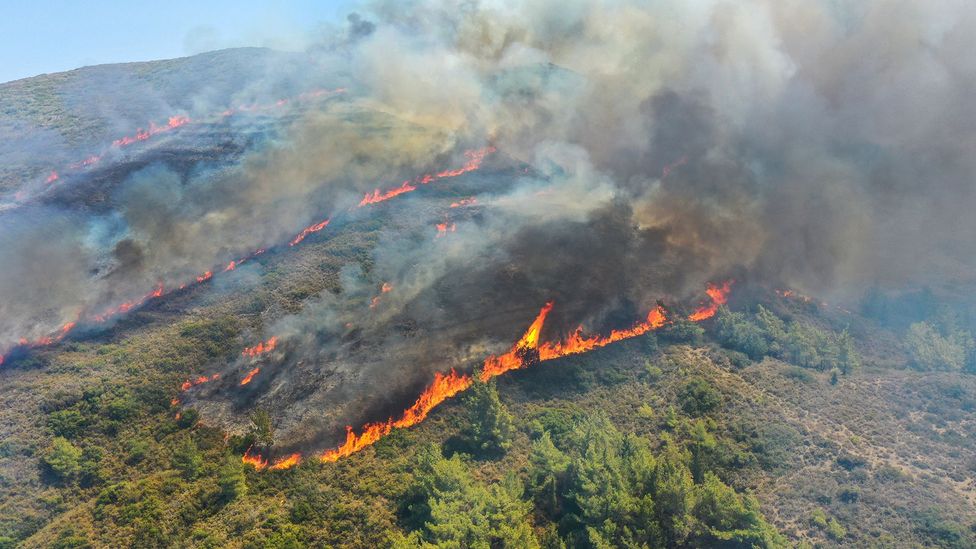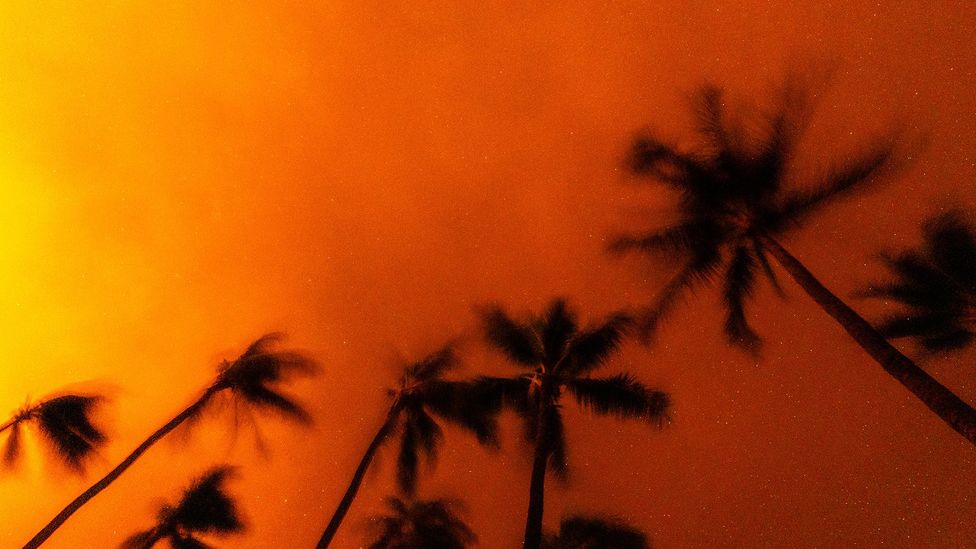It's a word that, in German, also means "hairdryer". And that's just what it's like. A hot, dry wind that sweeps down a mountainside, baking everything in its path. It is powerful enough to raise air temperatures by many degrees. This is the strange, and sometimes dangerous, weather event known as Föhn.
This year, it has cropped up many times, including during heatwaves where it has pushed temperatures up to unbearable levels in local, literal, hotspots.
Earlier this month in Taiwan, for example, Föhn winds were associated with 39C (102F) heat in the southeast of the country. The same kind of wind has also potentially exacerbated the intense heatwave in France and some speculate that it helped to generate the tinder-dry conditions that supercharged devastating wildfires in Maui, Hawaii, which have killed at least 106 people.
The Föhn effect can occur in much colder places, too, even Antarctica, where it can contribute to the rapid collapse of ice shelves. And, in 2018, it was blamed for forcing a significant volume of ice away from the coast of Greenland.
The weird potency of Föhn winds might not stop there. There is a long-standing folk belief that they can cause negative psychological effects, such as depression and suicidal thoughts. While there is limited hard evidence for that, it's fair to say that Föhn winds are not to be taken lightly. Science, thankfully, can help us understand them – and the risks they pose.

Föhn winds can cause wildfires to behave erratically and have been blamed for creating the conditions that have led to recent blazes in Greece (Credit: Getty Images)
"Usually, you need some sort of mountain or a range of hills for the Föhn effect to happen," says Liz Bentley, chief executive of the Royal Meteorological Society. A moist wind will rise up one side of a mountain to reach cooler air, where moisture then condenses out to form clouds or rain near or at the peak, she explains: "That releases energy out into the atmosphere," causing air temperatures to rise.
You might also be interested in:
- How wildfires create their own weather
- Why scientists are worried about ocean heatwaves
- The troubling way heatwaves warp your mind
The wind then pushes on down the other, leeward side of the mountain where cloudless conditions allow the sun to heat it up even further. Air temperatures might rise by 10C (18F) or more. One record from 1972 in the US even suggests that a Föhn wind event in Loma, Montana, pushed the local temperature up from -48C (-54F) to 9C (49F) – a rise of 57C (103F) in just 24 hours. A similar phenomenon saw temperatures in Cut Bank, Montana, rise by 29C (52F) in just one hour in January 2020.
More commonly, Föhn winds can lead to temperature differences of several degrees. One 30-year study in the Southern Appalachian Mountains found they elevated temperatures by at least 3C (5F) compared to nearby locations not affected by the winds. And an event on 2 January 1999 saw a narrow band of warm air move through the Great Tennessee Valley, on the northwest side of the Smoky Mountains, that was 10C (18F) warmer than the surrounding areas.
Once you have global warming and the normal variability like Föhn winds contributing, it all acts together and gives you the heatwave you've never seen before – Jim Overland
The term Föhn comes from the Alpine region of Europe but the same effect has been given different names elsewhere in the world. In parts of the US, such as in the Rocky Mountains and Alaska, they are known as Chinook winds, while in California people use the term Santa Ana to refer to the same phenomenon.
In Argentina, the Föhn effect is known as Zonda, while in South Africa it is Bergwind. Spanish people in Valencia call it Ponentà. And in the UK the Föhn wind that occurs in the Pennines in northern England is known locally as the Helm Wind. All of them can be classified as downslope windstorms.
The phenomenon is likely to become all the more significant in the coming years, says Jim Overland, an Arctic meteorologist at the US's National Oceanic and Atmospheric Administration (NOAA), since we expect to see longer, more frequent and more intense heatwaves due to climate change.
"Once you have global warming and you have the normal variability like Föhn winds contributing, it all acts together and gives you the heatwave you've never seen before," he says.
On 8 August, a terrifying wildfire, described as a "fire hurricane" by the Hawaiian governor, swept through the popular seaside town of Lahaina in Maui. A combination of factors influenced the eruption of the fire, including warm temperatures, low humidity, dry grasses in the area and strong winds from a nearby hurricane. However, a downslope windstorm, or Föhn effect, was perhaps also partly to blame, according to some expert observers.
Föhn winds might indeed have been at work here, says Craig Clements, director of the Wild Fire Interdisciplinary Research Centre at San José State University, in California, though he notes the Lahaina fires were shaped largely by powerful winds all over the area at the time.
The Föhn effect has often cropped up in association with serious wildfires, says Clements. He mentions examples in California and Greece. And it has been linked to forest fires in the southern Cape of South Africa, such as the deadly Knysna fires of 2017. They have also been found to cause erratic wildfire behaviour around the Canadian Rockies, where they can drive trigger "explosive" uphill blazes and at times drive flames downhill.
"One thing that people don't realise is it can dry the fuel," says Clements, referring specifically to grasses. "The fuels can go from [having] a dew on them to being critically dry in an hour." This is particularly problematic because fires can spread so quickly in grasses.
The rapid influence of Föhn winds on the environment is noticeable in other places, such as on snowy mountain ranges where the onset of the phenomenon can rapidly melt snow and ice. Some people call the winds "snow-eaters" in recognition of this, says Clements.
There is ongoing research into whether Föhn winds have psychological effects on human beings, to see whether there is any truth in the old folk beliefs from the Alps. One study in 2020 analysed data on nearly 72,000 mental health-related hospitalisations across a 35-year period in Bern, Switzerland and found that Föhn winds were associated with a 5% increased risk of such hospitalisations. Clements, though, suggests that it is difficult to prove with certainty that the winds really were the cause of patterns like this as other confounding factors could play a role.
Either way, clearly, they can have strong effects on the weather and fires in certain places, and it's important to be aware of the risks they pose, says Bentley.
"There's nothing you can do to stop the wind," she says – but it's important to be prepared if the effect can occur in your own part of the world, especially if there is a risk of dangerously high temperatures or deadly wildfires.
--
Join one million Future fans by liking us on Facebook, or follow us on Twitter or Instagram.
If you liked this story, sign up for the weekly bbc.com features newsletter, called "The Essential List" – a handpicked selection of stories from BBC Future, Culture, Worklife, Travel and Reel delivered to your inbox every Friday.
